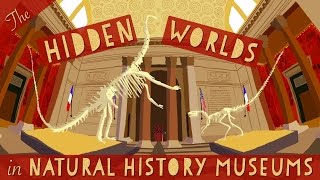(单词翻译:单击)
When you think of natural history museums,
当你想到自然历史博物馆时,
you probably picture exhibits filled with ancient lifeless things, like dinosaurs meteroites, and gemstones.
你可能会想起各种古老又毫无生命的陈列品,比如恐龙,陨石和宝石。
But behind that educational exterior,
在充满教育意义的外表的背后,
which only includes about 1% of a museum's collection,
这些仅仅占博物馆收藏品的1%,
there are hidden laboratories where scientific breakthroughs are made.
这里隐藏着进行许多科学技术突破的实验室。
Beyond the unmarked doors, and on the floors the elevators won't take you to, you'd find windows into amazing worlds.
在没有标示的门后,在搭乘电梯无法到达的楼层上,你会发现一个让你进入令人惊奇的世界的窗口。
This maze of halls and laboratories is a scientific sanctuary that houses a seemingly endless variety of specimens.
这个由走廊和实验室构建而成的迷宫堪称科研的圣殿,因为它储藏着无穷而多样的标本。
Here, researchers work to unravel mysteries of evolution, cosmic origins, and the history of our planet.
在这里,科研人员致力于解开进化论的谜团,宇宙的起源和地球的历史。
One museum alone may have millions of specimens.
任何一座自然历史博物馆都可能有数百万的标本。
The American Museum of Natural History in New York City has over 32,000,000 in its collection.
座落于纽约市的美国自然历史博物馆,收藏的标本就超过三千两百万件。
Let's take a look at just one of them.
让我们看看其中的一件。
Scientists have logged exactly where and when it was found and used various dating techniques to pinpoint when it originated.
科学家们准确地记录下找到这件标本的时间和地点,并采用各种年代测定技术,精确判断它发源于何时。
Repeat that a million times over, and these plants, animals, minerals, fossils,
他们重复以上步骤一百万次以上,这些植物,动物,矿石,化石
and artifacts present windows into times and places around the world and across billions of years of history.
和文物所呈现的是世界各地在不同时期的样貌,并且跨越数十亿年的历史。
When a research problem emerges, scientists peer through these windows and test hypotheses about the past.
当一个研究问题浮现时,科学家们透过这些标本所呈现的画面并测试对过去的假设。
For example, in the 1950s, populations of predatory birds,
例如,在20世纪50年代,对鸟类的捕食,
like peregrine falcons, owls, and eagles started to mysteriously crash,
例如游隼,猫头鹰和老鹰的数量开始神秘地骤减,
to the point where a number of species, including the bald eagle, were declared endangered.
若干鸟类甚至濒临灭绝,其中包括秃头鹰。
Fortunately, scientists in The Field Museum in Chicago had been collecting the eggs of these predatory birds for decades.
万幸的是,美国芝加哥自然历史博物馆的科学家们几十年来一直在收集这些捕食鸟类所产的蛋。

They discovered that the egg shells used to be thicker
他们发现蛋壳以前比较厚,
and had started to thin around the time when an insecticide called DDT started being sprayed on crops.
而从杀虫剂DDT开始被用于农作物上时,蛋壳开始变薄。
DDT worked very well to kill insects, but when birds came and ate those heaps of dead bugs, the DDT accumulated in their bodies.
DDT杀虫效果非常显著,但当鸟类吃了成堆的这些死虫,DDT进而在鸟类体内堆积。
It worked its way up the food chain and was absorbed by apex predator birds in such high concentrations
DDT成为了食物链的一部分,位于食物链顶端的捕食鸟类吸收了高浓度的DDT,
that it thinned their eggs so that they couldn't support the nesting bird's weight.
以至于产下的蛋壳都变薄了,薄得无法承受巢鸟的重量。
There were omelettes everywhere until scientists from The Field Museum in Chicago, and other institutions,
碎鸡蛋遍地都是,直到美国芝加哥自然历史博物馆的科学家们和其他机构的专家
helped solve the mystery and save the day.
一起解开了谜团,挽救了局面。
America thanks you, Field Museum.
美国感谢您,自然历史博物馆。
Natural history museums windows into the past have solved many other scientific mysteries.
自然历史博物馆给了我们窥视历史的窗口,从而解决了许多其他科研的谜团。
Museum scientists have used their collections to sequence the Neanderthal genome,
博物馆科学家们曾利用馆藏计算出穴居人的染色体序列,
discover genes that gave mammoths red fur, and even pinpoint where ancient giant sharks gave birth.
发现了猛玛象的红毛基因,甚至精确的定位古老巨鲨的分娩的地方。
There are about 900 natural history museums in the world,
世界各地大约有900座自然历史博物馆,
and every year they make new discoveries and insights into the Earth's past, present and future.
每一年,它们都会有新的发现和有关于地球的过去、现在和未来的见解。
Museum collections even help us understand how modern threats,
博物馆藏品甚至能帮助我们理解现世的危机,
such as global climate change, are impacting our world.
例如,全球气候变化正在影响着我们的世界。
For instance, naturalists have been collecting samples for over 100 years from Walden Pond,
举个例子,在过去的100年里,自然学家从瓦尔登湖采集样本,
famously immortalized by Henry David Thoreau.
瓦尔登湖因为美国先验论者亨利·戴维·梭罗而闻名于世。
Thanks to those naturalists, who count Thoreau among their number,
由于这些自然学家参考了梭罗的纪录,
we know that the plants around Walden Pond are blooming over three weeks earlier than they did 150 years ago.
我们才知道瓦尔登湖一带的植物比起150年前开花期提早了3个星期。
Because these changes have taken place gradually,
因为这些变化发生得很缓慢,
one person may not have noticed them over the span of a few decades,
人们在几十年间可能无法察觉这类变化,
but thanks to museum collections, we have an uninterrupted record showing how our world is changing.
但是多亏了博物馆的藏品,我们才有连续的纪录,向我们展示世界不断的变化。
So the next time you're exploring a natural history museum,
所以下一次当你探索一所自然历史博物馆时,
remember that what you're seeing is just one gem of a colossal scientific treasure trove.
记住,你所看到的只是巨大科研宝藏中的一颗宝石。
Behind those walls and under your feet are windows into forgotten worlds.
在那些墙的背后,在你的脚下,是进入被人遗忘的世界的窗口。
And who knows? One day some future scientist may peer through one and see you.
谁知道呢?也许在未来某天,科学家们会从其中的一个窗口看到你。


